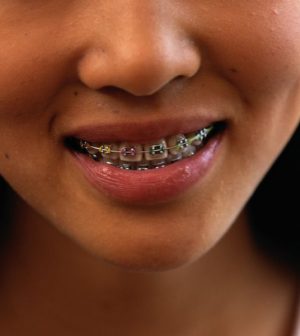- Navigating Your Midlife Crisis: Embracing New Possibilities
- City Raccoons Showing Signs of Domestication
- Mapping the Exposome: Science Broadens Focus to Environmental Disease Triggers
- One Week Less on Social Media Linked to Better Mental Health
- Your Brain Changes in Stages as You Age, Study Finds
- Some Suicide Victims Show No Typical Warning Signs, Study Finds
- ByHeart Formula Faces Lawsuits After Babies Sickened With Botulism
- Switch to Vegan Diet Could Cut Your Greenhouse Gas Emissions in Half
- Regular Bedtime Does Wonders for Blood Pressure
- Dining Alone Could Mean Worse Nutrition for Seniors
Need Braces? Say Goodbye to ‘Metal-Mouth’ Taunts

Braces have long been a kind of geeky right-of-passage — something that must be endured for a few years to ensure a lifelong smile with straight teeth.
Fortunately, braces have evolved over the years. They’ve gotten smaller and more options are available for those who need them, according to the U.S. Food and Drug Administration.
Straightening teeth is not just for kids and teens. The American Association of Orthodontics said 1 out of 5 orthodontic patients is over age 21. (Orthodontics is the branch of dentistry dealing with the straightening of teeth.)
And braces aren’t just for cosmetics. It’s easier to clean straight teeth that have the right amount of separation between them, the FDA said.
Your dentist or orthodontist will determine what type of braces are best for you. The FDA explains what options are available:
Metal braces move teeth by applying pressure and typically consist of small brackets cemented to the teeth, connected by a wire and held to the brackets by rubber bands. The wire is regularly tightened to gradually shift your teeth and jaw.
These types of braces may be clear- or tooth-colored to make them less obvious. And some people like to personalize the look of their braces with colored rubber bands.
A big drawback to metal braces is that it’s easy for food to get stuck in them. Be extra careful when you brush to keep your teeth clean and free of food material, the FDA said.
So-called invisible braces, or aligners, are made of clear plastic material and worn over your teeth to straighten them. You’ll wear each custom-made aligner for a few weeks, and then get a new one for the next stage of your treatment. This approach gradually moves teeth into the correct position.
Aligners are removable and need to be taken out before you eat, brush and floss. It is much easier to maintain good dental hygiene with aligners than with metal braces.
The average time a person needs to wear braces is two years, but the time can be longer or shorter depending on the individual.
Retainers are worn nightly after a person no longer has braces. The retainer helps maintain tooth position so that the bone in the tooth can solidify in the new position, according to the FDA.
More information
The Academy of General Dentistry has more on braces.
Source: HealthDay
Copyright © 2025 HealthDay. All rights reserved.










